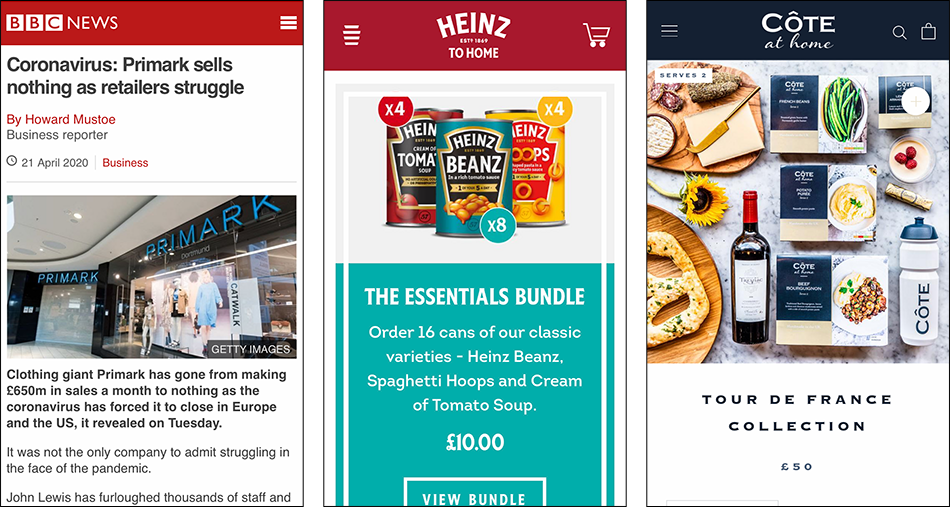This article first appeared on the Transform to Digital blog.
Marketing Week recently published a cartoon of a group of people in a meeting room where the speaker is saying digital transformation is years away, but outside we can see a giant wrecking ball labelled ‘Covid-19’ flying towards them at speed.
There have been clear winners and losers as millions moved to online shopping and working from home. Primark went from sales of £650m a month to zero with no online sales operation to fall back on. But other companies moved quickly to introduce new or bolster existing digital operations – as Microsoft CEO Satya Nadella observed: “We’ve seen two years’ worth of digital transformation in two months”.
Heinz moved into direct to consumer sales launching its Heinz to Home service offering boxes of family favourites, baby food and sauces. Côte Brasserie, faced with shuttered restaurants, started packing pre-prepped dishes and shipping them directly to customers.

Research by Waitrose revealed that 77% of UK consumers now do at least part of their regular grocery shopping online with 40% saying this was going to be a long-term change to the way that they shop. It’s no different for B2B buyers either if their regular supplier has been unable to service an order or has temporarily ceased or scaled-back operations they have had to seek alternative suppliers to keep their own business running.
With social distancing and supply chain disruption likely to remain for some time, the changes to shopping habits that during lockdown were a necessity-have turned into a routine and will soon become the norm. Marks & Spencer certainly think so, having just announced 7,000 job losses from their retail stores as their customers move decisively to online shopping.
I think what we have seen over the last few months is simply an acceleration of what we expected to happen over the next few years; the decline of retail and a move to eCommerce. But this means that many companies who had transformation plans in place have just had a giant ‘Covid-19’ wrecking ball smash right through them and those who had yet to start find themselves even further behind in the rush to transform.
So, if you are in this situation and find yourself having to accelerate change and catch up with customers who may now be shopping elsewhere, how can you respond quickly and make sure you’re delivering services ready for the ‘new normal’?
1. Talk to your customers
You were talking to them before Covid-19 came along about your plans for digital transformation, making sure you were meeting their needs. So, talk to them again, find out what has changed for them and how they are fulfilling those needs today.
Pay particular attention to customers who used to purchase from you but have gone quiet – where are they buying from now? What can you do to tempt them back? Is this a short-term change or has something more significant happened in the market?
But make sure you also talk to new customers who have bought from you during lockdown. What made them use your company? Was it a necessity or have you found a whole new market for your products and services as a result of the pandemic?
Make sure you talk to your sales force too. They will have first-hand knowledge of how your customers are coping with change. They will also be able to give you insights into how your competitors are adapting, any new services they are developing and any more fundamental changes they can see in your market.
2. Review your plans
Armed with all this new insight, update your customer personas, then start to review and assess your product backlog. Is everything you have planned for development still aligned to your customer’s needs and to changes in the market? If your income has reduced, you may also need to assess whether you have the resource available to deliver each item or whether they will have to wait for sales to recover.
You may find that functionality that was a ‘nice to have’ a few months ago is now a ‘must’ or that whole new services need to be documented and added to your backlog. But, hopefully, for every new task that you create, you’ll find others you can remove or that a simple change to the order of delivery is all that is required.
I don’t think Tesco are too concerned that Heinz has started selling regular deliveries of baked beans direct to the consumer. But suppose your sector has seen seismic shifts over the last few months. In that case, it may be necessary to move beyond merely reprioritising your roadmap and re-evaluate your entire digital transformation strategy.
3. Focus on MVP
One of the clear learnings of the past few months is that basic functionality executed quickly will always beat more advanced functionality delivered later. So whether you have to make significant changes to your strategy or more straightforward tactical changes now is the time to focus on identifying the minimum viable product required to deliver your digital transformation.
You may have produced a twelve-month plan to deliver a new eCommerce platform with prosaic product descriptions, beautiful product photography and world-class user experience. But now, because of Covid-19, your customers are disappearing, and you’re in a battle to survive.
So it’s time to stop building that Rolls-Royce solution and look for something faster and more economical.
Focus on delivering the absolute minimum functionality required to launch your service or keep your existing customers. Once you have done this, you can incrementally improve your proposition and add new functionality (always guided by your customers).
At the start of lockdown, my mother was told to shield, which meant she shouldn’t go out shopping. Supermarket delivery slots were in short supply, but I found a local wholesaler that had pivoted to B2C sales. Their website looked amateurish; the product descriptions were sketchy; the delivery notifications were simple. But they successfully delivered food every time we placed an order – the Ford Fiesta worked. And that was all we needed.
Don’t panic!
Reading this may fill you with dread. The world has turned upside down; your plans are in tatters. But as I was writing this post, a quote from Simon Sinek dropped into my inbox – “A finite mindset seeks certainty. An infinite mindset sees opportunity in uncertainty”.
The world has undoubtedly changed, nobody is sure what the ‘new normal’ will be, but change creates opportunities – you need to be agile enough in your thinking and execution to take advantage.
If you still feel overwhelmed at the prospect of accelerating your digital transformation project help is at hand. Transform to Digital is a specialist consultancy focusing on transformational eCommerce strategies and can help you create and execute a digital plan to transform your whole business rather than launch a website.
